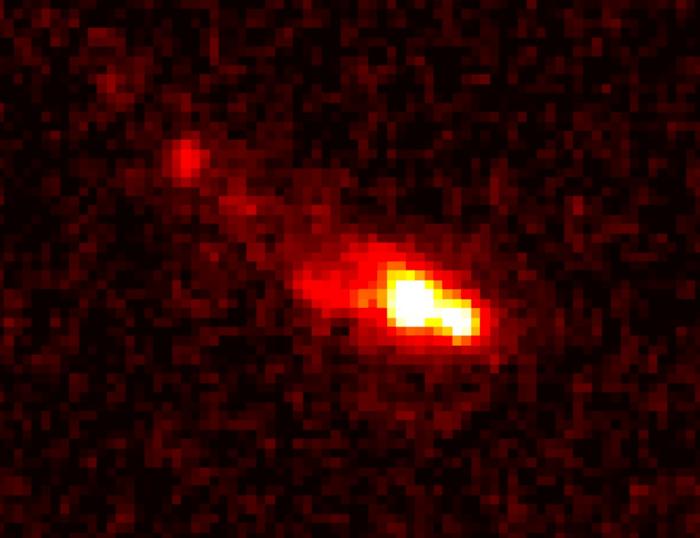Webb Watches the Most Distant Galactic Merger Ever Seen
By Carolyn Collins Petersen
Astronomers know that galaxies form through mergers. They’ve been happening since the earliest epochs of cosmic time. Using the Webb telescope (JWST) astronomers found a massive merger of young galaxies going on about a half million years after the Big Bang. It’s called Gz9p3, one of the earliest and most distant mergers ever witnessed.
The creation of Gz9p3 involves some incredibly massive galactic components, according to astronomer Kit Boyett from the University of Melbourne in Australia. “When we conducted these observations, this galaxy was ten times more massive than any other galaxy found that early in the Universe,” Boyett said.
JWST spectroscopic observations of the early Universe have uncovered the existence of galaxies existing only 300 million years after the Big Bang. The fact that it’s now seeing them merging only a couple of hundred million years later—as Gz9p3 is doing—suggests that the stars in those galaxies were born and evolved much faster than astronomers expected. That, in turn, puts a whole new spin on events in the earliest epochs of time.
Details of Galactic Mergers
The observations made by Boyett and his team show Gz9p3 divided into merging groups. One group has two “pieces”; it has a long tail of material stretching out as if it had been dragged away. That suggests at least two galaxies are coming together to create the larger one, according to Boyett. “The merger hasn’t finished yet,” he said. “We can tell this by the fact we still see two components. The long tail is likely produced by some of the matter being cast aside during the merger. When two things merge, they sort of throw away some of the matter. So, this tells us that there’s a merger and this is the most distant merger ever seen.”
Thanks to JWST’s powerful ability to look that far back in time, astronomers are rapidly changing their models of the early Universe. That’s because it can “see” the light from those early objects stretched into the infrared spectrum. And, what it sees are galaxies that have gotten very massive very fast through mergers. “With JWST we are seeing more objects in the early cosmos than we expect to see, and those objects are more massive than we thought as well,” said Boyett. “Our cosmology isn’t necessarily wrong, but our understanding of how quickly galaxies formed probably is, because they are more massive than we ever believed could be possible.”
Mergers and Young Stars
In the paper where Boyett and his team describe their merger studies of Gz9p3, they also look at the stars existing in the merging galaxies. They aren’t quite what Boyett and the team expected. That’s because most studies show very young stars at that time, and they show up because they’re brighter and their light dominates the imaging data. JWST’s spectral studies, however, allow astronomers to sort the younger stars from older ones.
“When we compared our spectrum analysis with our imaging, we found two different things. The image told us the population of stars was young, but the spectroscopy spoke of stars that are quite old. But it turns out both are correct because we don’t have one population of stars but two,” Boyett said. “The old population has been there for a long time and what we believe happens is the merger of the galaxies produces new stars and that’s what we’re seeing in the imaging—new stars on top of the old population.”
Setting the Stage for Star Birth
That last part makes sense since mergers spur shock waves that sweep through the galaxies. The shock fronts push material together, and that in turn leads to the birth of new stars. JWST allows astronomers to look at the fine details of both populations of stars. And, using that data they can fine-tune their models of star birth, galaxy formation, and mergers in the early Universe.

Boyette said that the team’s simulations do produce a very similar-looking object to the one they observed. “However, it’s incredibly rare,” he said. “So rare there’s only one of these in the whole model. The chance of us observing that with our observations, suggests we are either incredibly lucky or our simulations are wrong, and this sort of object is more common than we think. The thing we think we’re missing is that stars were forming much more efficiently and that may be what we need to change in our models.”
Indeed, the team’s paper suggests that with efficient star formation in the period right at the end of the Epoch of Reionization, astronomers could expect to see more objects like Gz9p3. That implies further observations with JWST and improved modeling to understand the stars and galaxies involved.
For More Information
A Massive Interacting Galaxy 510 Million Years After the Big Bang
ArXiv preprint
JWST Reveals a Massive and Ancient Galaxy that Challenges Our Models of the Young Universe
The post Webb Watches the Most Distant Galactic Merger Ever Seen appeared first on Universe Today.

March 25, 2024 at 08:08AM
via Universe Today read more...

Post a Comment